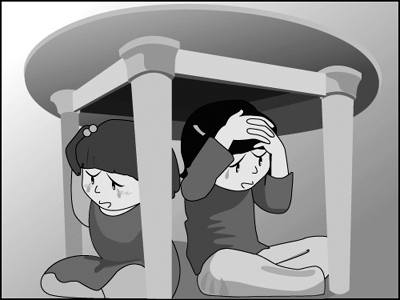Japanese university students share emergency tips through internet

The Web site, (http://nip0.wordpress.com) was established on March 14. Thanks to its multilateral and specific guidance, the Web site succeeded in gaining worldwide attention.
Before an earthquake, the Web site suggests checking if helmets, water, emergency provisions, an emergency kit and sleeping bags are available at home. Also, it says to close curtains to prevent damage from scattering glass, and to use a towel to keep door from jamming when buildings are shaking hard and lock people inside.
In case of an earthquake, the site recommends opening windows and doors to secure exits, putting necessities close to the home’s entrance where they will be easily accessible, wearing thick-soled shoes, closing the main gas tab, and charging cell phones while possible.
It is also possible to get real-time information about the earthquake in Japan through the Web site. Moreover, it lists contact numbers for 29 countries’ embassies.
The Web site also provides information to non-Japanese on how to deal with earthquakes and other natural disasters. It includes 29 translated versions of the basic guide for what people need to do in case of evacuation after an earthquake.
As for the victim of the earthquake in Tohoku and Kanto region, Japanese are highly assessed with their calm and safety measures.
“We receive evacuation training from elementary school to high school twice a year,” Kondo Akiko (Momoyama Gakuin, 4), who is currently attending Ewha as an exchange student, said. “Furthermore, at home, we always prepare water and food and even keep copy of our passports so we can evacuate with the utmost safety in any emergency situation.”
After the earthquake in Japan, questions arose about whether Korea is safe or not.
“Living in a neighboring country, it is true that the earthquake in Japan brought worries on Korea’s own preparation for earthquakes and natural disasters,” Han Na-rae (Korean, 2) said. “In response, Korea needs to make sure whether it is safe from earthquakes, and prepare for what Korea may face, too.”
Even with the worries, the experts still see Korea as secure.
“It is true that most of the buildings in Korea are not designed to be earthquake-resistant,” Professor Kim Kyu-han (Science Education) said. “The bill for earthquake-resistant design was recently passed and it is only applied to high story buildings. However, according to plate tectonics, Korea faces a much lower chance of affronting earthquakes. In other words, the Korean peninsula is located southeast of the Eurasian Plate and the famous earthquake plates, which lowers the probability of an earthquake occurring.”
With geological evidence, Korea seems to be safer from what Japan has experienced. However, the preventive measures and basic knowledge are mandatory.
“As Japanese people showed to the world, in case of natural disasters, people must stay calm and keep order,” Kim said. “Because life is the most important of all, people will need to comply with life-saving preventive measures.”
Park Kyung-min & Jang Youn-hee
uxkrkals@ewhain.net & janet9106@ewhain.net

